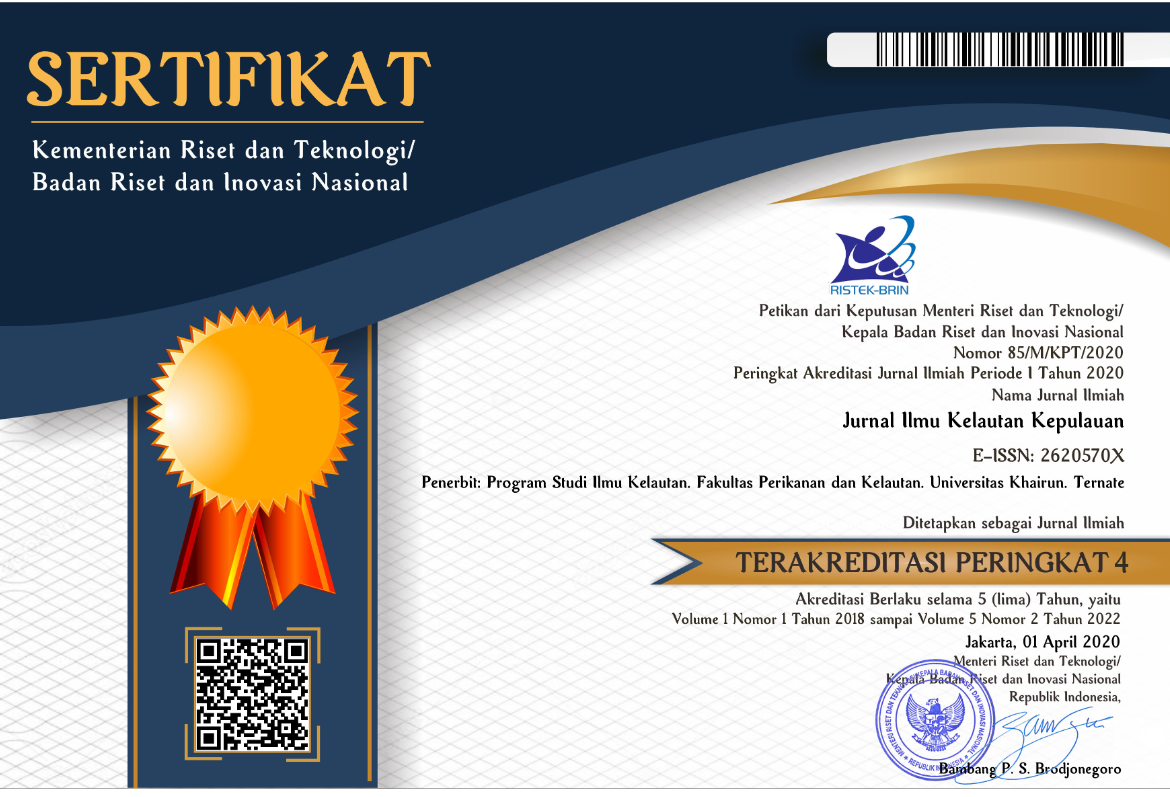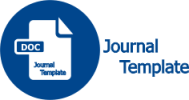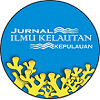Jurnal Ilmu Kelautan Kepulauan is dedicated to publish highest quality original research papers and critical review articles on all aspects in Marine science and Technology, Oceanography, Aquatic resources management, Aquaculture, Fish capture technology, Fisheries product technology, Marine and fisheries biotechnology, Marine geographic information system, Marine pollution and bioremediation, Climate change, and marine renewable energy which has not been previously published (either in whole or in part), and not under consideration for publication elsewhere. The manuscripts could be written in English and Indonesia.
GUIDELINES FOR ONLINE SUBMISSION
The author should first register as author and/or offer to be a reviewer via the following address: https://ejournal.unkhair.ac.id/index.php/kelautan/user/register The author should complete those sections of the form marked with a star in as much detail as possible and when author register and then choose and tick on “Author: Able to submit items to the journal”. Following the completion of all the text boxes, the author clicks on the “Register” button to activate the registration process. The author is then brought to the online author submission interface where he/she should click on “New Submission”. In the “Start a New Submission” section, click on “Click Here: to go to Step One of the five-step submission process”. The following are the five steps of the online submission process:
- Step 1 - Starting the Submission: This journal accepts submissions in several languages. Choose the primary language of the submission.
- Step 2 – Uploading the Submission: To upload a manuscript to this journal, click on “Browse” on the “Upload Submission” file item, select the manuscript document file to be submitted, then click on the “Upload” button.
- Step 3 – Entering Metadata: In this step, detailed author metadata should be entered, including the marked corresponding author. The manuscript title, abstract, and references must then be uploaded by copying the text and pasting it into the textbox, including keywords.
- Step 4 – Uploading Supplementary Files: This optional step allows Supplementary Files to be added to a submission. The files, which can be in any format, might include (a) research instruments, (b) data sets, which comply with the terms of the study's research ethics review, (c) sources that otherwise would be unavailable to readers, (d) figures and tables that cannot be integrated into the text itself, or other materials that add to the contribution of the work. A supplementary file should be uploaded. Click on the “Browse” button, choose the files and then click on the “Upload” button.
- Step 5 – Confirming the Submission: Authors should conduct a final check of the uploaded manuscript documents at this stage. To submit the manuscript to Jurnal Ilmu Kelautan Kepulauan, press the “Finish Submission” button after the document’s content has been verified. The corresponding author or principal contact will receive an acknowledgment by email and will be able to view the submission’s progress through the editorial process by logging onto the journal’s web address site.
Following submission, authors who submit a manuscript will receive an email confirming receipt enabling them to track their submission status at any time by logging onto the online submission interface. The submission tracking includes both the status of the manuscript review and editorial process.
GUIDELINES FOR MANUSCRIPT PREPARATION
Type of paper
Contributions falling into the following categories will be considered for publication: Research Article, and Review, that are accepted which have not been submitted and would not be submitted elsewhere.
1. Research Article
Present an original and important major advance in marine science and fisheries field having a wide research scheme and deep discussion of the findings. The structure of the article consists of Introduction, Research Methods, Results and Discussion, Conclusion, Acknowledgment (optional), and References. This article should be typed within not excess than 15 pages or 3500-7000 words (including figures and tables).
2. Review Article
An evaluation and critical interpretation of recent research, data, and concepts in the field of marine sciences and fisheries field. This article should be typed within more than 15 pages or minimum 7000 words (including figures and tables).
Manuscripts Format
Manuscript should present an original and important finding of research paper and review article in related field of marine and fisheries. (Template Article)
Manuscript should be written in font of Times New Roman 12, double space in A4 paper with 4 cm top margin and 2.5 cm for other three margins. Page numbers should be located at the bottom right of each page. Total length of the manuscript approximately 15 pages. For soft copies, we only accept in microsoft word saved in virus free file.
Manuscript should be written in the following order ie. Title, Author(s) full name; Author(s) full address; Email correspondence author; Abstract; Keywords; Introduction; Research Methods; Results and Discussion; Conclusion; Acknowledgment; References. For manuscript written in Bahasa Indonesia should follow similar arrangement.
Title
Title should be concise and as informative as possible. Title should be written in font of Times New Roman 14, single space, capital letters only at the beginning of the title (except for the name of the places), bold, and in the middle (center).
Author’s Data
Author’s Data should be written in font of Times New Roman 12. Author(s)’s full name (no abbreviation) and author full address, complete with postcode as well as email address.
Abstract
Title of abstract should be written in capital letters (ABSTRACT) and bold using font of Times New Roman 10 and single space. The content of abstract should be no more than 250 words, left and right aligned, the whole abstract is one paragraph, summarize the principal points of the study and therefore must be meaningful without reference to the body of the paper. It contains short sentences of introduction, methods, important findings, conclusion and implications. The abstract does not contain references, figures, tables, abbreviation, or acronym.
Key words: 5-8 words which have to be closely related to the research
Introduction
Introduction should provide sufficient background information of the research to evaluate the results of the research, but an extensive review of the literature is not needed and in general, no exceeds one typed page. The introduction also gives the rationale for and objectives of the study that is being reported and their relationship to earlier work in the field
Research Methods
In this section, author(s) should provide sufficient information to allow another qualified researcher to repeat the experiments that are described in the paper. If the method is categorized as new procedures or refers to published paper which was not readily available for most readers, details methodology should be provided. If any modification is being made, then it should be described clearly. Previously published procedures should be cited. The authors should also mentioned scientific name, number of samples and the location of sampling. Sources (company, city, state, or country) of unusual chemicals, bacterial strains, reagents, and equipment must be clearly stated. For those who work with satellite images, please also provide collected ground check data.
Results and Discussion
Results and discussion should not be separated. State the obtained results based on the used methods. Avoid presentation of raw data as well as double presentation (e.g. table and graph). Every means value of the data should be given standard deviation. All data given in result should be presented in the tables or graph, although some results may be given solely in the text.
Discussion can be done by comparing results/data reported with other research results previously published. Focused on the interpretation of the results rather than a repetition of the results/data. Similarities, differences, and the uniqueness of the findings should be highlighted.
Conclusion
The conclusions should not be a summary of the results and discussion but the implications of the research findings. Based on the findings and discussion, conclusion should be clearly stated. It should be written as paragraph, not as a list.
Acknowledgment
In this section, author(s) should mention the grant source (Institution as well as year of the contract) and the person to whom the grant was given. Acknowledgement should also be given to those (individual/company/institution) who has contributed to the study especially in establishing research design, acquisition of data, supplying documents/photographs or analysis and interpretation of data, or who was involved in drafting the manuscript or revising it critically for important intellectual content. If the contribution of an individual quite significant, then he/she should be put as one of the author. Please refer to author(s) contribution form.
References
References only list the published or accepted material for publication. Accepted article(s) but not yet published should be sent as manuscript appendix. Refering website, personal communications, unpublished data should be incorporated in the text in parentheses. Personal communication need to be written with the initials surname of the source accompanied with the year of the statement, e.g., (Jaja, 2020, personal communication). Authors should provide proof(s) of the communication such as email, etc.
References should be listed alphabetically by the last names of the authors. In the case of several authors have same name, references should be listed chronologically. Only the first author’s name and initials are inverted. Journal names are italicized and abbreviated according to those commonly used in international journal (see ISI journal abbreviation).
In the text it should be referred by the name(s) of the first author followed by the year of publication in parentheses, using the following format: (Akbar and Naja, 2020) or Marsono and Rini (2020). When there are more than two authors, use the first author’s name followed by et al. (written in italics). When several references are put in the same parentheses, it should be typed from the oldest year (Ricardo and Zain, 2005; Prayoga and Yusuf, 2010; Munawir and Tri, 2015; Suwarti et al., 2021). If the references have the same year, they should be listed alphabetically. If the references have the same author(s) and the same year, they should be listed by giving a lowercase a, b, c, etc. after the year of publication.
The reference list should follow these styles:
Journal article
Craig J.S., P.H. Barber, Ambariyanto & A.C. Baker 2010. The Recovery of Coral Genetic Diversity on Krakatau. Coral Reefs. 29:547–565
Book
Nei M. & S. Kumar 2000. Molecular Evolution and Phylogenetic. Oxford University Press. 333 pp.
Chapter in a book
Waldman J.R. & I. Wirgin 1994. Use of DNA Analysis in the Management of Natural Fish Populations. In: Garte, S.J. (Ed). Molecular environmental Biology. Lewis Publishers. Boca Raton. Florida. p: 29-64.
Book by editor(s)
Garte, S.J. (Ed). 2000. Molecular environmental Biology. Lewis Publishers. Boca Raton. Florida. 256 pp.
Thesis or dissertation
Zulhan H. 2020. Dinamka Iklim dan Laut di Wilayah Kepulauan Indonesia. Thesis. Khairun University. Ternate. 320 pp.
Publication with no identifiable author or editor
Anonymous. 2011. Real decree 3-484/2000 (12 January 2001) on the hygiene of ready-to-eat foods. BOE no. 11. Boletín Oficial de Estado, Madrid, Spain.
Article from Internet
Refering to web page(s), it should include author, date, title, availability information, and accession date. For example:
Choi, C.Q. 2008. Giant Clams Fed Early Humans. Available at: http://www.livescience.com/2808-giant-clams-fed-early-humans.html. Accessed 9 February 2020.
Conference Proceedings
Wijayanti D.P., E. Indrayanti & C.A. Suryono 2011. Kajian konektivitas genetika antar terumbu sebagai dasar perencanaan kawasan restorasi karang dalam upaya mengahadapi global warming. Anonymous (Ed.) Simposium Nasional Penelitian Perubahan Iklim. Semarang, 26 Juli 2011. Kementerian Lingkungan Hidup dan Universitas Diponegoro. p: 15-20.
Tables
Tables should be prepared in word (.doc file). The legend of the table should be brief with enough information needed. It should be self-explain so that it’s understandable without extensive reference to the text. Each column in a table must have a heading, and abbreviations, when necessary, should be defined in the legend. Use no vertical lines, but only three horizontal line is. under the title, under the box heads, and at the bottom. Give standard deviation to every mean value. Numbers and legend of the table should be written in 10 point Times New Roman font. Data presented in tables must not be repeated in figures.
Figures
Maximum width of figures should not exceeded 150 mm. Figures or photographs should be in very good quality (at least 300 dpi) and ready to print. In the case of figures containing multiple components (for example Figure 1A, 1B, 1C, etc.) should be mounted together. Each number should be put on the upper-right corner of the page. Black and white photographs should be clear and contrast enough to provide necessary information to the readers. Figures and photographs can be printed in color, but there is an additional cost to the author. Color quotes will be provided after acceptance of the manuscript. Numbers and legend are written in 10 point Times New Roman font. Measurement scale should be given to photographs and arrows should be given to point certain objects. Images should be prepared in JPG format. Clear credit should be given to the photographer. Statistical graphs should give standard deviation for mean value. Data presented in figures must not be repeated in tables.
Proofs
Proofs will be sent by E-mail to the correspondence author and are expected to proofread the article carefully. The corrected proof should be received by the administration within three working days.
Privacy Statement
The names and email addresses entered in this journal site will be used exclusively for the stated purposes of this journal and will not be made available for any other purpose or to any other party.
Article Processing Charge
Jurnal Ilmu Kelautan Kepulauan is an open access journal. Readers can read and download any full-text articles for free of charge (fully Open Access).
Started from the manuscript published on June 2019, Author should pay an Article Processing Charge (APC) of IDR 500.000) per article. Once the manuscript accepted, an invoice will be sent to the Author. The accepted article will not be published until the APC was paid. The APC will be used for maintaining the DOI registration and the full text PDF articles production cost.
Submission through OJS
Jurnal Ilmu Kelautan Kepulauan encourages manuscript submission through the Open Journal System (OJS) at the following address: https://ejournal.unkhair.ac.id/index.php/kelautan/index. For a certain period of time, we will accept submissions by e-mail ilmukelautanunkhair@yahoo.com. We hope the new submission procedure will make the process of article submission, review and publication more efficient and comfortable for everyone involved.
As part of the submission process, authors are required to check off their submission's compliance with all of the items in the manuscript preparation check list, and submissions may be returned to authors that do not adhere to these guidelines. For those who are not familiar with the system should be sent the manuscript filled and signed authors contribution and copyright statement forms to:
Submission Preparation Checklist
As part of the submission process, authors are required to check off their submission's compliance with all of the following items, and submissions may be returned to authors that do not adhere to these guidelines.
- The submission has not been previously published, nor is it before another journal for consideration (or an explanation has been provided in Comments to the Editor).
- Always put clear correspondence address including email
- We encourage that references used should be no older than 10 years
- Submitted graphs and picture/photos including maps should be in a very good quality to be printed.
- The text adheres to the stylistic and bibliographic requirements outlined in the Author Guidelines, which is found in About the Journal.
- If submitting to a peer-reviewed section of the journal, the instructions in Ensuring a Blind Review have been followed.
- Copy this form and after filling it, please send it to ilmukelautanunkhair@yahoo.com:
AUTHOR CONTRIBUTION FORM
Title of Manuscript:
............................................................................................................................................................................................
Please indicate below which author(s) is/are responsible for each phase of the study.
|
Concept & Research Question: |
|
|
Conducting Research:
|
|
|
Statistical Analysis:
|
|
|
Manuscript Writing: |
|
|
Other Things (please explain): |
|
By signing, the author(s) certify that standards for authorship have been met, the final manuscript has been read and approved, and that neither the submitted manuscript nor any significant part has been not submitted for publication elsewhere or previously published.
|
Name of Authors
|
Author’s Signature |
Date |
|
|
|
|
|
|
|
|
|
|
|
|
Copyright Notice
Copy this form and after filling it, please send it to ilmukelautanunkhair@yahoo.com:
COPYRIGHT TRANSFER STATEMENT
When this article is accepted for publication, its copyright is transferred to Jurnal Ilmu Kelautan Kepulauan. The copyright transfer covers the exclusive right to reproduce and distribute the article, including reprints, translations, photographic reproductions, microform, electronic form (offline, online) or any other reproductions of similar nature.
The author warrants that this article is original and that the author has full power to publish. The author signs for and accepts responsibility for releasing this material on behalf of any and all co-authors. In regard to all kind of plagiarism in this manuscript, if any, only the author(s) will take full responsibility. If the article is based on or part of student’s skripsi, thesis or dissertation, the student needs to sign as his/her agreement that his/her works is going to be published.
Title of article :...........................................................................................................................
Name of Author(s) :...........................................................................................................................
Author’s signature :...........................................................................................................................
Date :...........................................................................................................................
Privacy Statement
The names and email addresses entered in this journal site will be used exclusively for the stated purposes of this journal and will not be made available for any other purpose or to any other party.
© 2023 Jurnal Ilmu Kelautan Kepulauan







